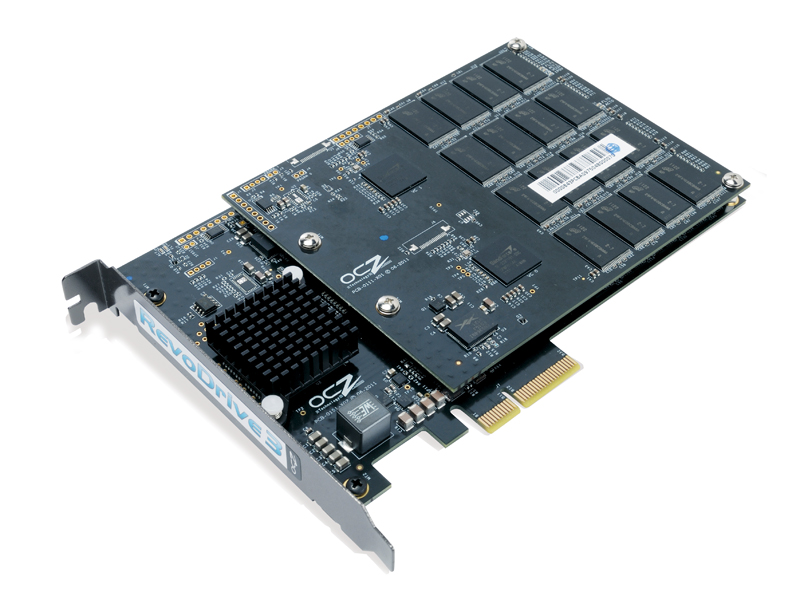TechRadar Verdict
Pros
- +
Insane sequential performance
- +
Easy to install
- +
Bootable
Cons
- -
TRIM support still a problem
- -
Random access performance disappoints
Why you can trust TechRadar
Too much performance is a nice problem to have. It is still a problem though, especially in the context of some solid state drives. But not the new OCZ RevoDrive 3 X2 480GB.
OCZ claims it's capable of read speeds up to 1.5GB/s. That's monumental bandwidth by any measure and much, much more than even the latest SATA 6Gbps interface can handle. In practice, a mere 500MB/s of sequential bandwidth can be enough to saturate a SATA interface.
That's why drives powered by the latest SandForce SSD controller, such as OCZ's own Vertex 3 or Corsair's Force GT, can't quite reach their full potential on a SATA connection. There's simply not enough available bandwidth.
But the OCZ RevoDrive 3 X2 480GB is no ordinary SSD. It sports no less than four of the snazziest Sandforce SF-2281 controller chips. It is, in effect, four 120GB Sandforce-powered SSDs running in a parallel RAID array for maximum performance.
Crucially, however, it hooks them in via a speedy four-lane PCI Express connection. On paper, that allows up to 2GB/s of bandwidth. In other words, if the RevoDrive 3 doesn't deliver on its theoretical capabilities, it won't be able to point the finger at the SATA port. And some capabilities the Revodrive has, if OCZ's performance claims are accurate.
The headline figures include sequential read and write figures of 1,500MB/s and 1,225MB/s. Those are very, very big numbers. Not long ago, anything over 100MB/s seemed quick. But with this drive, OCZ is dragging storage into the GB/s era.
However, it's worth remembering we're talking about an SSD with SandForce controllers. Those peak numbers involve compressible data. Throughput with incompressible data will inevitably be lower.
Then there's the question of random access rather than raw sequential bandwidth. OCZ pegs the RevoDrive 3 X2 480GB at 200,000 IOPs for 4k aligned random writes, which bodes well. But as we've learned, when it comes to SSD random access performance, the practice doesn't always match the theory.
Performance is nothing without control, which is where OCZ's original RevoDrive PCI-e SSD fell short. It didn't support TRIM command or SMART data. Together these features help keep SSDs fast and fit. The good news is that the new RevoDrive 3 adds support for both. We'll get into the details momentarily, but the simple version is that it's OCZ's VCA 2.0 (Virtual Controller Architecture) software layer that works the magic. The bad news is that issues on the OS side remain. Again, more on that in a moment.
What we have, therefore, is a storage solution that seems to come tantalisingly close to offering the complete package. It's fully bootable. It's silly fast. And it delivers on its half of the TRIM support equation. But is it really that much better than an ordinary SSD or conventional RAID array?
First, a little lesson in nomenclature. The 'X2' in OCZ RevoDrive 3 X2 480GB means this is a double-decker card with a pair of PCBs. Think of it as two SSDs per board. Together, the two boards form a single drop-in PCI-e board in four-lane format.
So, you'll need at least one PCI-e port of minimum four-lane spec available in your PC. The RevoDrive 3 X2 will, of course, happily hook up to an eight or 16-lane PCI-e socket, though there are no performance benefits to be had.
Each of the two PCBs has a pair of cutting edge SF-2281 SandForce controllers and 240GB of asynchronous NAND flash split into 16 chip arrays. For the record, the flash chips are 25nm Micron items. That means lower write/erase longevity of around 5,000 cycles compared with the typical 10,000 or more cycles of previous generations of flash memory.
Exactly what impact this will have on SSD survival rates remains unclear. Clever wear-levelling algorithms do much to nullify the effect of fewer available cycles. What's more, the aggressive use of data compression by the SandForce controller further mitigates wear compared with other controller chipsets. But the overall trend towards fewer cycles still leaves us feeling a little queasy with an SSD that costs more than most PCs.
OCZ has cooked up a software layer that promises several benefits and has given the RAID hardware an overhaul to boot. Gone, therefore, is the convoluted series of chips found in the first RevoDrive that converted SATA to PCI X and then PCI-e. Instead, there's a single chip that channels four SAS ports through to four PCI-e channels and it's much cleaner and simpler.
On top of the RAID chip sits a virtualised software layer known as VCA 2.0. The trick here is to present the four SSDs as a single device and in turn enable TRIM along with SMART data, native command queuing and more.
Technology and cars. Increasingly the twain shall meet. Which is handy, because Jeremy (Twitter) is addicted to both. Long-time tech journalist, former editor of iCar magazine and incumbent car guru for T3 magazine, Jeremy reckons in-car technology is about to go thermonuclear. No, not exploding cars. That would be silly. And dangerous. But rather an explosive period of unprecedented innovation. Enjoy the ride.
